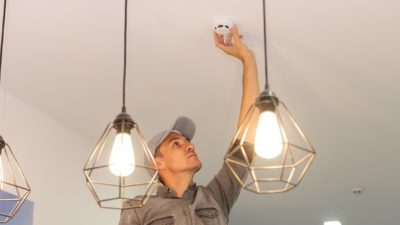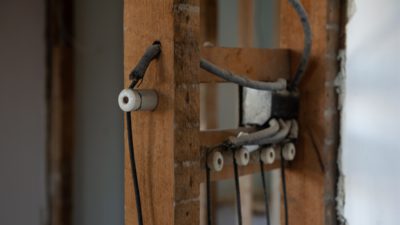Whether you’re looking for a new place to rent or buy, energy efficiency should be one of the must-haves on your list. While you’re browsing through listings online, attending open houses, and touring with your real estate agent, keep energy efficiency on your radar. Look around and get a good idea of how energy efficient your potential new home is and what you would need to do to make it better. Here are some things to consider during your home search.
How old are the appliances?
Take note of how old the appliances are in the home and if they are ENERGY STAR certified. This will be important as your appliances will impact how much you pay for energy use per month. For example, according to the U.S. Department of Energy (DOE), “if a refrigerator is from 2000 or earlier, a new ENERGY STAR certified model will use just half the electricity. When comparing new refrigerators, ENERGY STAR-certified models are about 9% more energy efficient than non-certified models.”
Older appliances use more energy, cost more money to operate, and are worse on the environment. Check the age and energy efficiency of the dishwasher, clothes washer, clothes dryer, refrigerator, oven, and microwave before making any decisions on moving in. If you need to upgrade some (or all) of the appliances, this is something you will want to consider as you think about your price range.
Do the windows let air in and out?
According to the U.S. DOE, “heat gain and heat loss through windows are responsible for 25–30% of residential heating and cooling energy use.” If you are renting and new windows are not an option available to you, or if replacing windows is outside of current budgetary restrictions, increase energy efficiency by caulking and weatherstripping, hanging window coverings like curtains, or adding exterior shade such as awnings. “When you are inspecting a living space, run your hand around the window edges to feel for air leaks—hot air coming in in summer or cold air in winter may signal higher energy bills ahead,” says the U.S. DOE. No matter what, it’s a great idea to get your whole home air sealed for improved comfort and savings.
If you decide to purchase new windows, click here for selection and installation advice.
Which side of the house faces the sun?
While we aren’t saying that the way your home is positioned should dictate your property choice, it can make a difference on your energy costs, especially if you plan to incorporate elements of passive solar design into your home now or in the future. Therefore, it’s something to think about! The U.S. DOE says that it’s best if “a portion of the south side of your house [has] an unobstructed ‘view’ of the sun.” If it seems like it’s set up nicely for energy efficiency, think about future tree growth and new building construction that could block the sun that you need. Windows “should face within 30 degrees of true south and should not be shaded during the heating season by other buildings or trees from 9 a.m. to 3 p.m. each day.”
What is planted outside?
Did you know that having trees in just the right places surrounding your home can save up to 25% of the energy a typical household consumes? For example, trees acting as dense windbreaks can protect your home from harsh winter winds while letting the sun in to warm up the place. The National Renewable Energy Laboratory (NREL) says that “a well-designed landscape will cut your summer and winter energy costs dramatically.” NREL also says that “the proper placement of only three trees will save an average household between $100 and $250 in energy costs annually.” If this is already done, that’s great! But if not, a typical energy efficiency landscaping project will save enough energy to pay for itself in less than 8 years. It is also recommended to check out the neighborhood as you drive or walk down the street. According to NREL, “studies by the Lawrence Berkeley Laboratory found summer daytime air temperatures to be 3°F to 6°F (2°C to 3°C) cooler in tree-shaded neighborhoods than in treeless areas.”
Is the insulation up to standards?
Don’t pass by the attic because there’s nothing to see. The insulation in the attic makes a huge difference in year-round comfort and energy savings. According to energystar.gov, 9 out of 10 homes are under-insulated so you will probably walk through some homes that aren’t up to current standards. Old or outdated insulation isn’t a dealbreaker because it can be fixed, but it’s something to note. If you have a chance to look at the current resident’s energy bills, and the costs are higher than you expect or desire, updating the insulation can help. If you’re a renter, there are special incentives for buildings with 2-4 units so that you won’t pay anything for getting the insulation up to today’s standards.
What do you know about the heating and cooling equipment?
According to the U.S. DOE, “approximately 43% of home energy costs are attributed to heating and cooling.” Before you sign on the dotted line, gather what information you can about the age of the systems, check if they’re ENERGY STAR certified, and see if any details of care regularity such as tune-ups are available. This will be important information, especially if you’re purchasing a home. Don’t worry if there isn’t a programmable thermostat or smart thermostat installed. That is an easy fix and there are rebates and no-cost items available through a Mass Save® Home Energy Assessment. There are also incentives to help with purchasing new HVAC equipment.
The U.S. DOE says that “in an existing house, the first step is to conduct a home energy assessment (sometimes referred to as an energy audit) to find out how your home uses energy and determine the best ways to cut energy use and costs,” and we couldn’t agree more.
If you’re a Massachusetts homeowner or renter, you can access a no-cost Home Energy Assessment and take advantage of all kinds of rebates and incentives to make your new place more energy efficient. Some of the perks include:
- No-cost items for your new home like LED light bulbs, advanced power strips, faucet aerators, energy-saving showerheads, and programmable thermostats
- 100% off air sealing for your home
- 75-100% off approved insulation upgrades
- Up to $2,750 in HVAC equipment rebates
- 0% financing with the Mass Save® HEAT Loan (up to $25K for 7 years)
- And more!
If you have just signed your lease or recently got the keys to the home you just purchased, call us at HomeWorks Energy at (781) 305-3319 or click here to get an assessment completed! We’ll give you a custom home energy report and we’ll show you how your home consumes and loses energy before you even move in. As long as your utilities are set up, you’re good to go. You can get access to big rebates, incentives, and no-cost items, and you can learn how to make your place more energy efficient to save money and energy throughout the years ahead.








